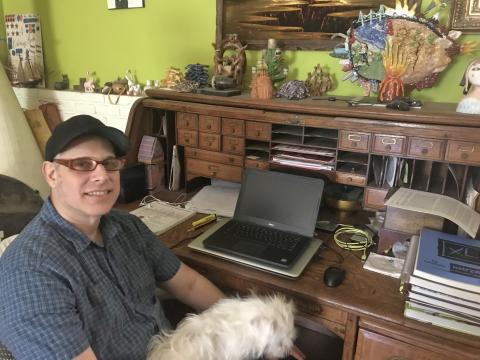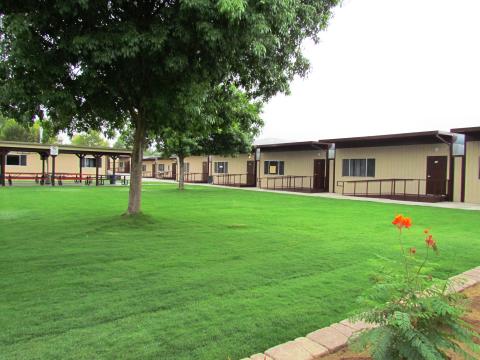When the new school year began in August, Noli Indian School welcomed two new teachers to its high school level staff. The Soboba Band of Luiseño Indians Reservation school serves 120 students in grades six through 12. The experienced teachers were getting used to the new campus while welcoming their students via distance learning. English teacher Daniel Alarcon and art teacher Adam Maron are both residents of Riverside that bring many years of experience to the classroom, albeit virtually.
Alarcon has taught all forms of English, including ESL and A.P. and has also coached swimming, track and wrestling teams. He served in the U.S. Army and after being honorably discharged felt he wanted to do as much good in the world as possible. He began as a substitute teacher in 2006 and went full time in 2008.
“The opportunity then presented itself to teach as an adjunct professor at the post-secondary level. I knew I didn’t want to stay teaching at the college level forever, but I also thought the experience would benefit me and my future students, so I did that for a few years,” he said. “I am happy to be teaching where I feel I am doing my best work. Education truly changes lives.”
When Alarcon learned of the position at Noli Indian School he was very interested.
“I always have been drawn toward areas where I feel I can make a positive impact; that’s where my passion lies,” Alarcon said. “After I met the principal and the some of the staff, I knew I wanted to be here. Having taught in a few different great schools and colleges, I can say some of the staff I have had the opportunity to collaborate with here at Noli are second to none.”
Maron is a longtime professional artist who has also taught art and ceramics to a diverse group of students at a Riverside Unified School District after-school program and for Riverside Arts Council affiliated programs. He turned to teaching in a school setting about two years ago.
“Art is my passion and passing art on to students is an amazing experience. Teaching at Noli enables me to give more attention to students and their individual needs and interests, due to the smaller class sizes,” Maron said. “Art at Noli allows students to express their individual selves and explore their cultural identity and traditions while at the same time exploring art and processes that they might not otherwise have access to. Native people have a deep and culturally significant identity to draw from, which makes for great art and artists in the making.”
Teaching online has challenged both teachers to be creative in their approach to their students and the curriculum.
“There are at least two parts that make up the lessons students should master,” Alarcon said. “The first is what I call the science of English Language Arts. This is the structure and forms which include grammar, mechanics, forms, and structures. This is what most people think of when they think of English class. But the second part is equally important: the art. It is how texts, whether informational texts, poetry, stories, visual media, or even social media affect and inform our world and our ability to navigate it. Most importantly, I hope all of our students are lifelong learners.”
Maron said he is a big proponent of the celebration and expression of cultural identity and thinks ceramics is a great way to express this through the process of finding and digging natural clay on the reservation, and creating traditional native paddled pottery known to this region.
“I want to see the students go through the traditional process and creation of these pieces and finish their pottery with surfaces and finishes that uniquely reflect the artist that made it,” Maron said. “I think hands-on studio work is vital and is more likely to hold the interest of the student and inspire creativity. I do like to present historical context and a background of art to each lesson. I feel it’s important to know where we have been in an art context in order to know where we are going. Art movements often happen in reaction to, or as a result of art that came before, and gives artists permission to innovate. I want students to have permission to innovate too, so I like them to have that knowledge going into a project.”
Alarcon feels that education is a personal journey and thinks an effective teacher is one who facilitates that journey and helps students reach their goals. The coronavirus pandemic has been part of that journey and has caused everyone to learn new ways to help students and use tools that are new as well.
“On a different level, technology presents some issues in terms of accessibility and dependence on some factors outside of our control like Wi-Fi, hardware, or software,” he said. “I think one of the largest positives is that we are all coming together to reach our goals. We are growing and rising to meet our challenges.”
Maron said that teaching online requires much more preparation and forethought on how to best serve students. He said that many of the ways in which a teacher teaches in the classroom vanish when teaching virtually and requires teachers to think differently about approaches that would normally be an afterthought in a classroom setting.
“Distance learning needs to be thought of as a partnership between teachers, students and parents. If one of these elements breaks down it can be a difficult road for all involved,” Maron said. “I think that students have less distractions and more supervision in a school environment. The biggest challenge for me is hands-on studio instruction. It is very difficult to physically show students how to do something without being there in person. I work daily thinking about what is working and what needs adjusting. The important thing I try to remember is that this situation is a communal experience, and hard for everyone involved. Noli has been very good about supplying students with art supplies which I think helps a lot and helps keep them on track with their studio work.”
Despite its limitations, Maron feels there is much that can be learned about education through the process of virtual learning.
“We can understand that many students need structure and this kind of proves it. Some do well with virtual learning, so this could be a way to customize learning for students that are self-sufficient and can handle less structure,” he said. “And of course, I have hopes that a peek into the world of teaching for people outside of education will help in understanding the importance of educators and that it’s a demanding job at times and is not only a career but a calling.”
Photos courtesy of the Soboba Band of Luiseño Indians





